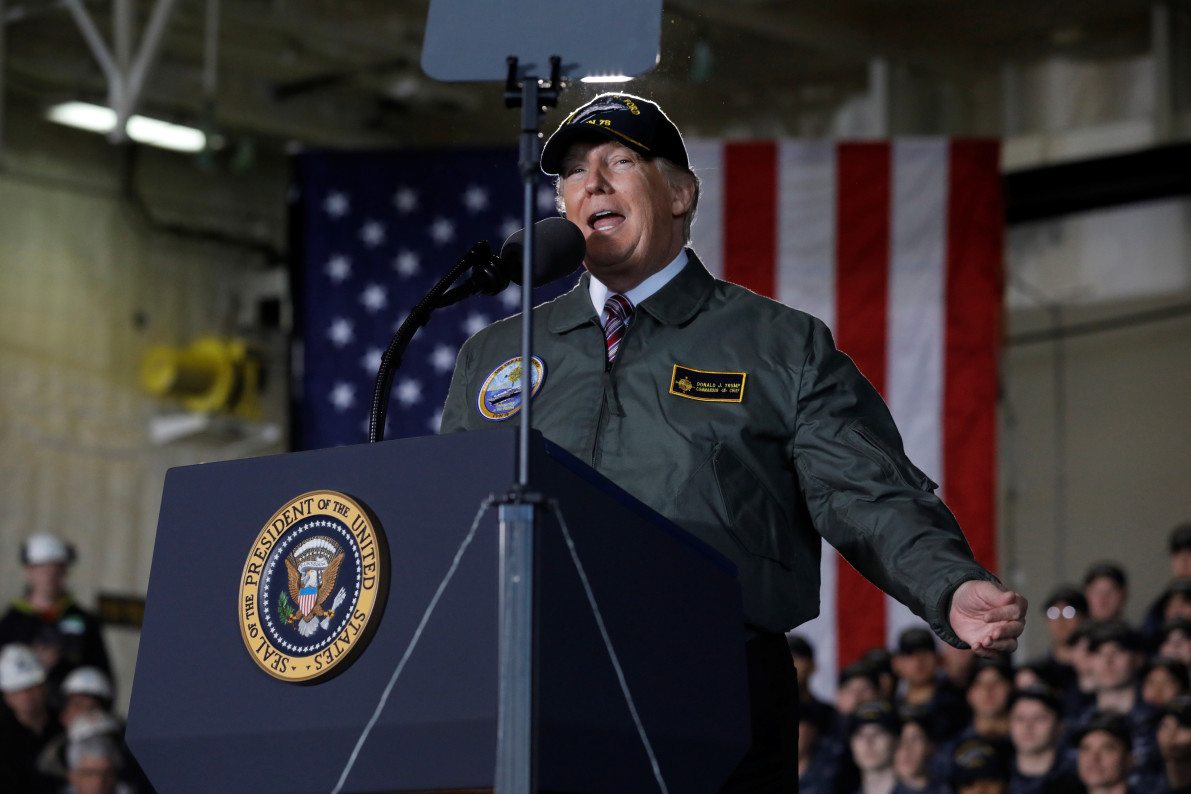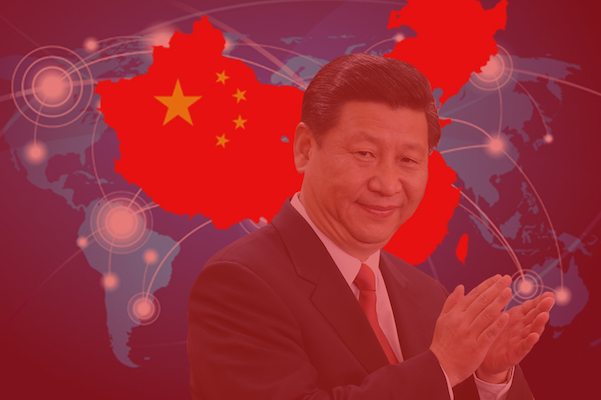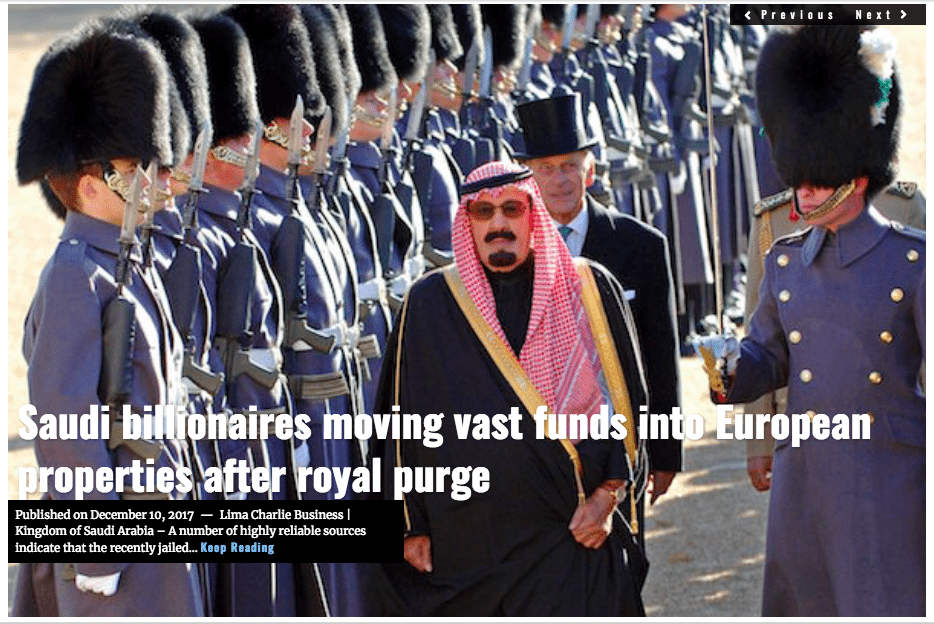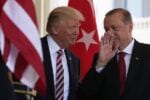On December 18th, the Trump administration revealed its new National Security Strategy (NSS).
For politicos and history buffs alike, it held few surprises. If summarized in a non nuanced fashion, one could say that the 68 page long document is a very conservative approach to the national security needs of the nation.
Many right-wing pundits are bound to love it for its outrageous throwback to the Reagan-era’s dogma and black and white mentality. Liberals are bound to hate it, because they will blindly hate on anything that carries the signature of the President.

This National Security Strategy puts America first.
-President Trump, 2017
Personally, I find the NSS fiercely simplistic and monotone. The document shows a mentality left behind in a much simpler world, harking back to the cowboys and Indians mentality of the Cold War. What is worse, is that it shows a willingness to impose that mentality on the entirety of the world.
As a think tank paper to bicker over, it would stand well. I might even read it and advocate some of its points. As the United States of America’s principle strategy in how to enforce security on its subjects, it stands as a glaring example of failed grand-geostrategy thinking.
What is the NSS?
History has a habit of repeating itself.
Ultimately, the National Security Strategy document is less a call for action and more a call for approval of how money is to be spent; a wordy and idealized justification of budget. The implementation of the document usually differs significantly from its written form. Often times, the on-the-ground difference between NSS changes borders into nothing.
The NSS came into existence through the stroke of a pen on October 4th, 1986, when President Ronald Reagan signed the Goldwater-Nichols Department of Defense Reorganization Act. The act was signed into legislation as a direct response to the insistence overlap, and rivalry for resources and operational areas between the armed forces branches. As the United States military presence grew in the post-World War II world, facing its new Cold War enemies, the inter-service rivalries became increasingly problematic.
President Reagan was, in part, elected due to President Jimmy Carter’s catastrophic failure in handling the Iranian hostage situation in 1980. The Carter administration’s actions culminated in Operation Eagle Claw, which saw 8 US servicemen killed and 4 injured.
Post-operational review of the incident showed that a considerable amount of the failures in mounting a proportional response to the dangerous situation at the US Embassy in Tehran was due to poor inter-service coordination and squabbling. Similar problems were found during the Pentagon review of 1983 Operation Urgent Fury, the Reagan-era invasion of Grenada.

As such, the Goldwater-Nichols Reorganization Act was the most comprehensive restructuring of the Department of Defense (DoD) since the department’s creation by President Harry S. Truman in 1947. Not only did Goldwater-Nichols change the power dynamics within the Joint Chiefs of Staff, it put the military chain of command firmly under the Executive Branch, i.e. the President, beyond its original expressed powers, as derived from the Constitution (Article II, Section 2).
Critics of the reorganization have pointed out that while streamlining of the military was very needed, the methods and restructuring to the upper echelons of the DoD only served to further solidify the politicalization of the military leadership. This resulted in the centralization of the chain of command through the Chairman of the Joint Chiefs, and the Secretary of Defense, towards the President, creating a situation where all sides facing the executive branch contained a degree of political inclination.
It was as part of Goldwater-Nichols that the NSS document was created. While it holds some similarity to the National Military Strategy (NMS), which was also introduced through the DoD reorganization act of 1986, it differs in that it is a less tactical and more generally written document. In its essence, the NSS is a further justification, or argument in favor of the latest defense spending bill, whereas the NMS is a significantly less idealistic document created with a narrow focus towards the tactical-strategic scope.
The NSS is at all times created by the civilian government branch, and describes the Executive Branch’s ambitions in terms of what methods the government will seek to use to engage the world, what tools and policies will be focused on, and ultimately, how the grand-strategy described in the NSS has developed since its previous incarnation. The NMS in turn is created as a supporting document by the Joint Chief of Staff, and equals the practical response to the idealistic NSS.
In the Special Operations and field intelligence community, the NSS could be made equal to the pre-mission planning stage often referred to as “what is on the table.” This means that one looks at a mental table, with each table end representing the extremes of what is to the mission profile’s disposal. The right end might contain such options as a nuclear strike, whereas the left end has the option of sending Dennis Rodman to play basketball with a dictator. Usually, for military operations, the middle is where the realistic options lay. The NSS tends to help define what options the US has in how it approaches the outside world, and what tools it will designate to its diplomatic, intelligence, and warrior frontline foot soldiers.
What’s new in this NSS?
“Preserving peace through strength, and advancing American influence in the world.”
-President Trump, 2017 National Security Strategy.
Usually the NSS’s creation is left to mid to high level members of the executive branch, seeking to adhere to the overarching objectives of the administration, all while the President is kept at a reasonable distance from getting overly vested in the particulars. As such, the results tend to be released as a representation of a united administration’s aspirations and thoughts.
What was unusual with this NSS is the amount of interest and involvement the President has seemingly taken in its construct. The Trump administration’s NSS has instead been released as though it was coming directly from the President.
This makes it further obvious that the NSS is uniquely written with the President in mind, reflecting his wishes and beliefs. The problem is that a lot of it comes off as either a pandering and meandering mess, or with serious gaps in the practical realm. Its mantra is predictably familiar, with strong nationalistic and isolationist resounding sound bites. America First. But this mantra is pushed at the expense of a less nuanced worldview, and the downgrading of several issues that have for the past administrations considered key issues.
Climate change is impacting stability in areas of the world where our troops are operating today.
-Secretary of Defense, James Mattis
Chief among the issues that have been downgraded is the long-standing notion that climate change is a concern for the national security of the United States. The absence of a firm climate change rhetoric in the NSS is hardly surprising, considering that just a few months ago the Trump administration pulled the US out of the Paris Climate Accord.
![Image Defense Secretary James Mattis before the Senate Armed Services Committee in Washington, June 13, 2017 [Thomson Reuters]](https://limacharlienews.com/wp-content/uploads/2017/12/James-Mattis.jpeg)
While the threat from North Korea gets several mentions in the document, 17 to be exact, there is very little talk of reduction of nuclear arms in the US, or the worldwide arsenal. Instead the focus, as far as North Korea goes, is on safeguarding national security through whatever means is deemed necessary.
The other very real and active threats from Islamic terrorism, and other more abstract foes are largely ignored in favor of the actual gloating of being the President that “crushed Islamic State of Iraq and Syria (ISIS) terrorists on the battlefields of Syria and Iraq, and will continue pursuing them until they are destroyed.”
Us vs. Them
Significantly more troubling though is the strategic implications of how the administration views the other global major powers. The two powers that are not entirely unjustly singled out are Russia and China. For example, on page 12 of the NSS, it states, “China and Russia challenge American power, influence, and interests, attempting to erode American security and prosperity.” The document goes significantly further and refers to the two parties as “revisionist powers,” and goes on to naively accuse them of attempting to further causes for their own gain.
Whereas previous administrations have approached their relationship with China and Russia out of a more laissez-faire viewpoint, in both the market and geopolitical field, the Trump administration appears to view its relationship with the rest of the global powers from a more overtly protectionist standpoint. The departure from previous administrations becomes the most apparent while discussing the US-Chinese relationship. The new focus is significantly more hawkish in the geostrategic sense. No doubt this rhetoric will be a welcomed move by the administration’s original grassroots supporters as it continues to pander towards its base.

Early on, the Trump NSS makes it clear that it views the world in a very binary fashion – Us vs. Them – favoring competition over cooperation. Seemingly, this competitive approach is so comprehensive that it even encompasses military action.
The NSS goes out of its way to hark back to mental images of a world long gone, the Cold War world, using neoconservative rhetoric. For those that have observed the President’s words vs. actions, this is no surprise. Trump has, throughout his short political career, appeared above averagely inclined to actually follow through on oft-repeated dogma. Maybe that is the most disturbing part, considering how Trump went out of his way during the election campaign to ignore why the US has been such a staunch supporter of a free worldwide market, even at the expense of its own domestic industries. This, despite that for most of the post-World War II decades, under the political and military dominance of the US, the West prospered through making alliances through open trade.
Pax Americana was ultimately not achieved through superior firepower, but through superior trade and production capabilities. With this trade practice came, albeit often naively placed and formalized, the American introduction of progressive causes such as human rights and democracy. This has become the traditional American approach to the world, and something that the Trump administration appears not to adhere to.
And so, with this NSS President Trump follows through on one of his less defined promises of reintroducing the world to the old binary worldview in the shape of a new Cold War, with the old favorites coming back to play. Obviously, the world was quick to respond to Trump’s plan.
Predictably, Russia responded by calling it an “imperial” strategy. China responded by saying that the approach would ultimately “only harm itself as well as others.” Hua Chunying, Deputy Director of the Foreign Ministry Information Department, went further and said that the document shows “an unwillingness to give up the idea of a unipolar world. Moreover, an insistent unwillingness, disregard for a multipolar world.”
What difference does it make?
“Defending America’s sovereignty without apology.”
-President Trump, 2017 National Security Strategy.
As uncomfortable as it is to be siding with Russian and Chinese spokespersons, I am inclined to partly agree. The new NSS does indeed remind one of something which would come out of 1988 rather than 2018. It reeks of isolationism in an age where that reality is nearly unthinkable, making overt enemies out of just about everyone not in blind support of the US under its glorious leader.
What is worse is that the NSS is neither a complete nor coherent framework. Adding to the isolationist tendencies placed throughout the document remains the very core American belief that it is the center of the world. As such, it must be heard at all times.
The NSS also drops several vital cornerstones in the politics of America’s Western allies, all while ignoring many of the realities found in the worldwide realpolitik scene. Speak, but not listen. Whereas the NSS has, for over three decades, been a good barometer for America, and its allies and foes, to gauge where the country is placing itself in the world, this latest iteration does little of that except to show that there is conflict ahead.
I suppose we will have to keep following the President on Twitter to find out more.
John Sjoholm, Lima Charlie News
John Sjoholm is Lima Charlie’s Middle East Bureau Chief, managing editor, and founder of the consulting firm Erudite Group. A seasoned expert on Middle East and North Africa matters, he has a background in security contracting and has served as a geopolitical advisor to regional leaders. He was educated in religion and languages in Sana’a, Yemen, and Cairo, Egypt, and has lived in the region since 2005, contributing to numerous Western-supported stabilisation projects. He currently resides in Jordan. Follow John on Twitter @JohnSjoholmLC
Lima Charlie World provides global news, featuring insight & analysis by military veterans, intelligence professionals and foreign policy experts Worldwide.
For up-to-date news, please follow us on twitter at @LimaCharlieNews
In case you missed it:

![Image President Trump's National Security Strategy - the New Cold War [Image: Lima Charlie News]](https://limacharlienews.com/wp-content/uploads/2017/12/President-Trumps-National-Security-Strategy-the-New-Cold-War.jpg)



![Image Memorial Day may soon be a remembrance of democracy and those who had the courage to defend it [Lima Charlie News]](https://limacharlienews.com/wp-content/uploads/2018/05/Memorial-Day-may-soon-be-a-remembrance-of-democracy-and-those-who-had-the-courage-to-defend-it-Lima-Charlie-News-480x384.png)
![A Trump war crime pardon dishonors us all [Lima Charlie News]](https://limacharlienews.com/wp-content/uploads/2019/05/A-Trump-war-crime-pardon-dishonors-us-all-Lima-Charlie-News-480x384.png)


![The Mind of Bolton - AUMF and the New Iran War [Lima Charlie News]](https://limacharlienews.com/wp-content/uploads/2019/05/Inside-the-mind-of-Bolton-Lima-Charlie-News-main-01-480x384.png)

![Image Memorial Day may soon be a remembrance of democracy and those who had the courage to defend it [Lima Charlie News]](https://limacharlienews.com/wp-content/uploads/2018/05/Memorial-Day-may-soon-be-a-remembrance-of-democracy-and-those-who-had-the-courage-to-defend-it-Lima-Charlie-News-150x100.png)